Ethics and Information Technology
VerifiedAdded on 2021/06/17
|9
|1926
|49
AI Summary
Contribute Materials
Your contribution can guide someone’s learning journey. Share your
documents today.
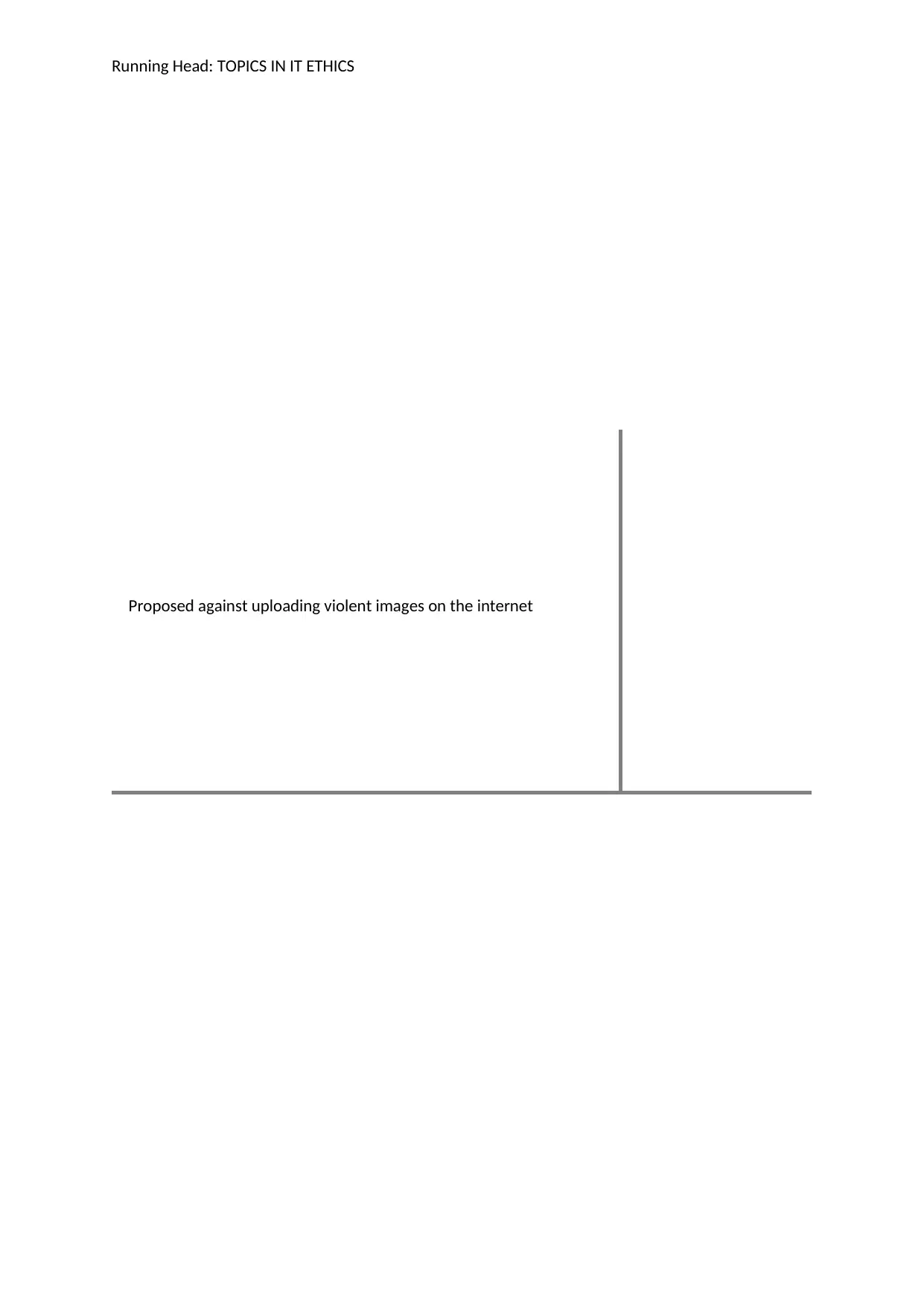
Running Head: TOPICS IN IT ETHICS
Proposed against uploading violent images on the internet
Proposed against uploading violent images on the internet
Secure Best Marks with AI Grader
Need help grading? Try our AI Grader for instant feedback on your assignments.
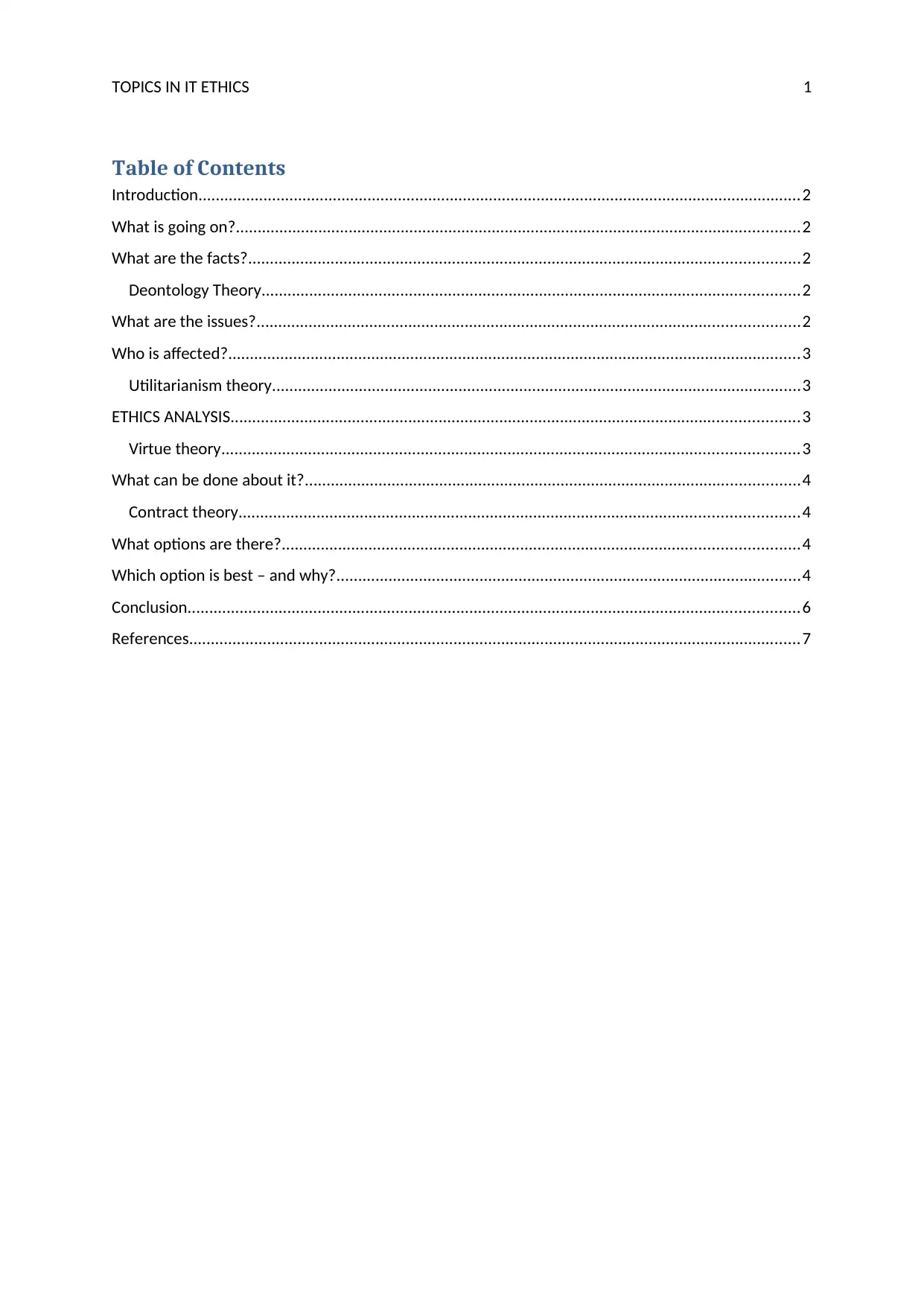
TOPICS IN IT ETHICS 1
Table of Contents
Introduction...........................................................................................................................................2
What is going on?..................................................................................................................................2
What are the facts?...............................................................................................................................2
Deontology Theory............................................................................................................................2
What are the issues?.............................................................................................................................2
Who is affected?....................................................................................................................................3
Utilitarianism theory..........................................................................................................................3
ETHICS ANALYSIS...................................................................................................................................3
Virtue theory.....................................................................................................................................3
What can be done about it?..................................................................................................................4
Contract theory.................................................................................................................................4
What options are there?.......................................................................................................................4
Which option is best – and why?...........................................................................................................4
Conclusion.............................................................................................................................................6
References.............................................................................................................................................7
Table of Contents
Introduction...........................................................................................................................................2
What is going on?..................................................................................................................................2
What are the facts?...............................................................................................................................2
Deontology Theory............................................................................................................................2
What are the issues?.............................................................................................................................2
Who is affected?....................................................................................................................................3
Utilitarianism theory..........................................................................................................................3
ETHICS ANALYSIS...................................................................................................................................3
Virtue theory.....................................................................................................................................3
What can be done about it?..................................................................................................................4
Contract theory.................................................................................................................................4
What options are there?.......................................................................................................................4
Which option is best – and why?...........................................................................................................4
Conclusion.............................................................................................................................................6
References.............................................................................................................................................7
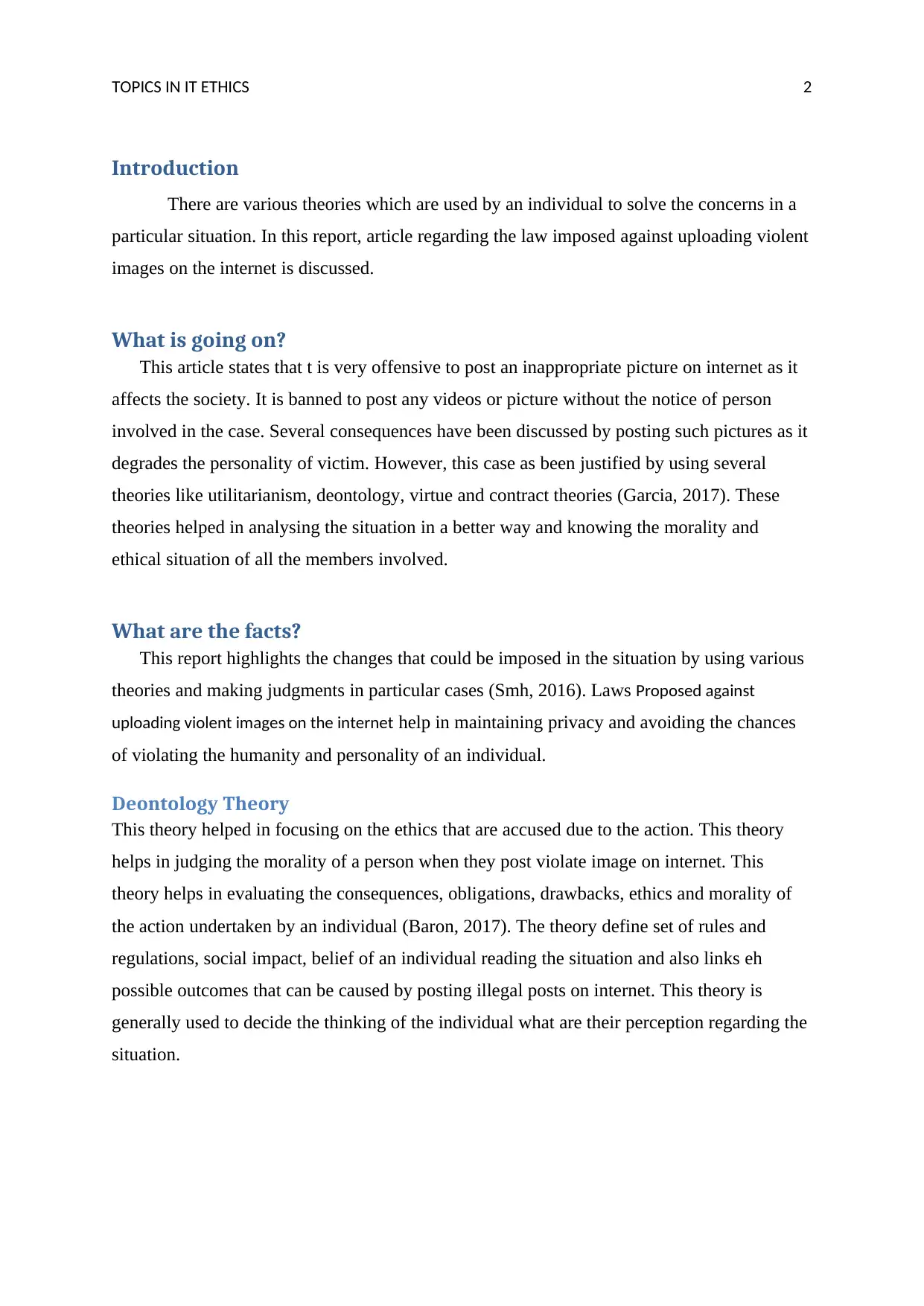
TOPICS IN IT ETHICS 2
Introduction
There are various theories which are used by an individual to solve the concerns in a
particular situation. In this report, article regarding the law imposed against uploading violent
images on the internet is discussed.
What is going on?
This article states that t is very offensive to post an inappropriate picture on internet as it
affects the society. It is banned to post any videos or picture without the notice of person
involved in the case. Several consequences have been discussed by posting such pictures as it
degrades the personality of victim. However, this case as been justified by using several
theories like utilitarianism, deontology, virtue and contract theories (Garcia, 2017). These
theories helped in analysing the situation in a better way and knowing the morality and
ethical situation of all the members involved.
What are the facts?
This report highlights the changes that could be imposed in the situation by using various
theories and making judgments in particular cases (Smh, 2016). Laws Proposed against
uploading violent images on the internet help in maintaining privacy and avoiding the chances
of violating the humanity and personality of an individual.
Deontology Theory
This theory helped in focusing on the ethics that are accused due to the action. This theory
helps in judging the morality of a person when they post violate image on internet. This
theory helps in evaluating the consequences, obligations, drawbacks, ethics and morality of
the action undertaken by an individual (Baron, 2017). The theory define set of rules and
regulations, social impact, belief of an individual reading the situation and also links eh
possible outcomes that can be caused by posting illegal posts on internet. This theory is
generally used to decide the thinking of the individual what are their perception regarding the
situation.
Introduction
There are various theories which are used by an individual to solve the concerns in a
particular situation. In this report, article regarding the law imposed against uploading violent
images on the internet is discussed.
What is going on?
This article states that t is very offensive to post an inappropriate picture on internet as it
affects the society. It is banned to post any videos or picture without the notice of person
involved in the case. Several consequences have been discussed by posting such pictures as it
degrades the personality of victim. However, this case as been justified by using several
theories like utilitarianism, deontology, virtue and contract theories (Garcia, 2017). These
theories helped in analysing the situation in a better way and knowing the morality and
ethical situation of all the members involved.
What are the facts?
This report highlights the changes that could be imposed in the situation by using various
theories and making judgments in particular cases (Smh, 2016). Laws Proposed against
uploading violent images on the internet help in maintaining privacy and avoiding the chances
of violating the humanity and personality of an individual.
Deontology Theory
This theory helped in focusing on the ethics that are accused due to the action. This theory
helps in judging the morality of a person when they post violate image on internet. This
theory helps in evaluating the consequences, obligations, drawbacks, ethics and morality of
the action undertaken by an individual (Baron, 2017). The theory define set of rules and
regulations, social impact, belief of an individual reading the situation and also links eh
possible outcomes that can be caused by posting illegal posts on internet. This theory is
generally used to decide the thinking of the individual what are their perception regarding the
situation.
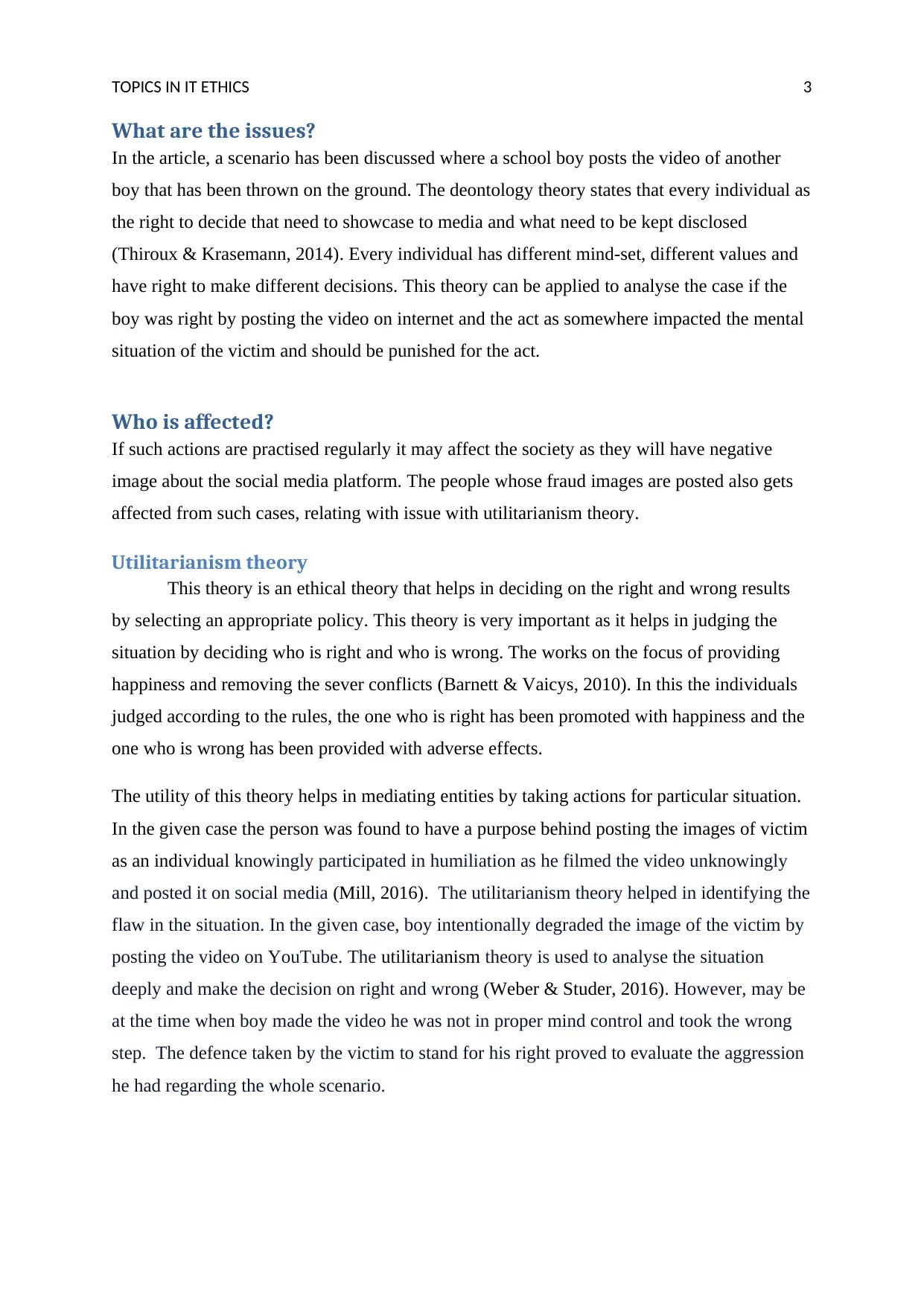
TOPICS IN IT ETHICS 3
What are the issues?
In the article, a scenario has been discussed where a school boy posts the video of another
boy that has been thrown on the ground. The deontology theory states that every individual as
the right to decide that need to showcase to media and what need to be kept disclosed
(Thiroux & Krasemann, 2014). Every individual has different mind-set, different values and
have right to make different decisions. This theory can be applied to analyse the case if the
boy was right by posting the video on internet and the act as somewhere impacted the mental
situation of the victim and should be punished for the act.
Who is affected?
If such actions are practised regularly it may affect the society as they will have negative
image about the social media platform. The people whose fraud images are posted also gets
affected from such cases, relating with issue with utilitarianism theory.
Utilitarianism theory
This theory is an ethical theory that helps in deciding on the right and wrong results
by selecting an appropriate policy. This theory is very important as it helps in judging the
situation by deciding who is right and who is wrong. The works on the focus of providing
happiness and removing the sever conflicts (Barnett & Vaicys, 2010). In this the individuals
judged according to the rules, the one who is right has been promoted with happiness and the
one who is wrong has been provided with adverse effects.
The utility of this theory helps in mediating entities by taking actions for particular situation.
In the given case the person was found to have a purpose behind posting the images of victim
as an individual knowingly participated in humiliation as he filmed the video unknowingly
and posted it on social media (Mill, 2016). The utilitarianism theory helped in identifying the
flaw in the situation. In the given case, boy intentionally degraded the image of the victim by
posting the video on YouTube. The utilitarianism theory is used to analyse the situation
deeply and make the decision on right and wrong (Weber & Studer, 2016). However, may be
at the time when boy made the video he was not in proper mind control and took the wrong
step. The defence taken by the victim to stand for his right proved to evaluate the aggression
he had regarding the whole scenario.
What are the issues?
In the article, a scenario has been discussed where a school boy posts the video of another
boy that has been thrown on the ground. The deontology theory states that every individual as
the right to decide that need to showcase to media and what need to be kept disclosed
(Thiroux & Krasemann, 2014). Every individual has different mind-set, different values and
have right to make different decisions. This theory can be applied to analyse the case if the
boy was right by posting the video on internet and the act as somewhere impacted the mental
situation of the victim and should be punished for the act.
Who is affected?
If such actions are practised regularly it may affect the society as they will have negative
image about the social media platform. The people whose fraud images are posted also gets
affected from such cases, relating with issue with utilitarianism theory.
Utilitarianism theory
This theory is an ethical theory that helps in deciding on the right and wrong results
by selecting an appropriate policy. This theory is very important as it helps in judging the
situation by deciding who is right and who is wrong. The works on the focus of providing
happiness and removing the sever conflicts (Barnett & Vaicys, 2010). In this the individuals
judged according to the rules, the one who is right has been promoted with happiness and the
one who is wrong has been provided with adverse effects.
The utility of this theory helps in mediating entities by taking actions for particular situation.
In the given case the person was found to have a purpose behind posting the images of victim
as an individual knowingly participated in humiliation as he filmed the video unknowingly
and posted it on social media (Mill, 2016). The utilitarianism theory helped in identifying the
flaw in the situation. In the given case, boy intentionally degraded the image of the victim by
posting the video on YouTube. The utilitarianism theory is used to analyse the situation
deeply and make the decision on right and wrong (Weber & Studer, 2016). However, may be
at the time when boy made the video he was not in proper mind control and took the wrong
step. The defence taken by the victim to stand for his right proved to evaluate the aggression
he had regarding the whole scenario.
Secure Best Marks with AI Grader
Need help grading? Try our AI Grader for instant feedback on your assignments.
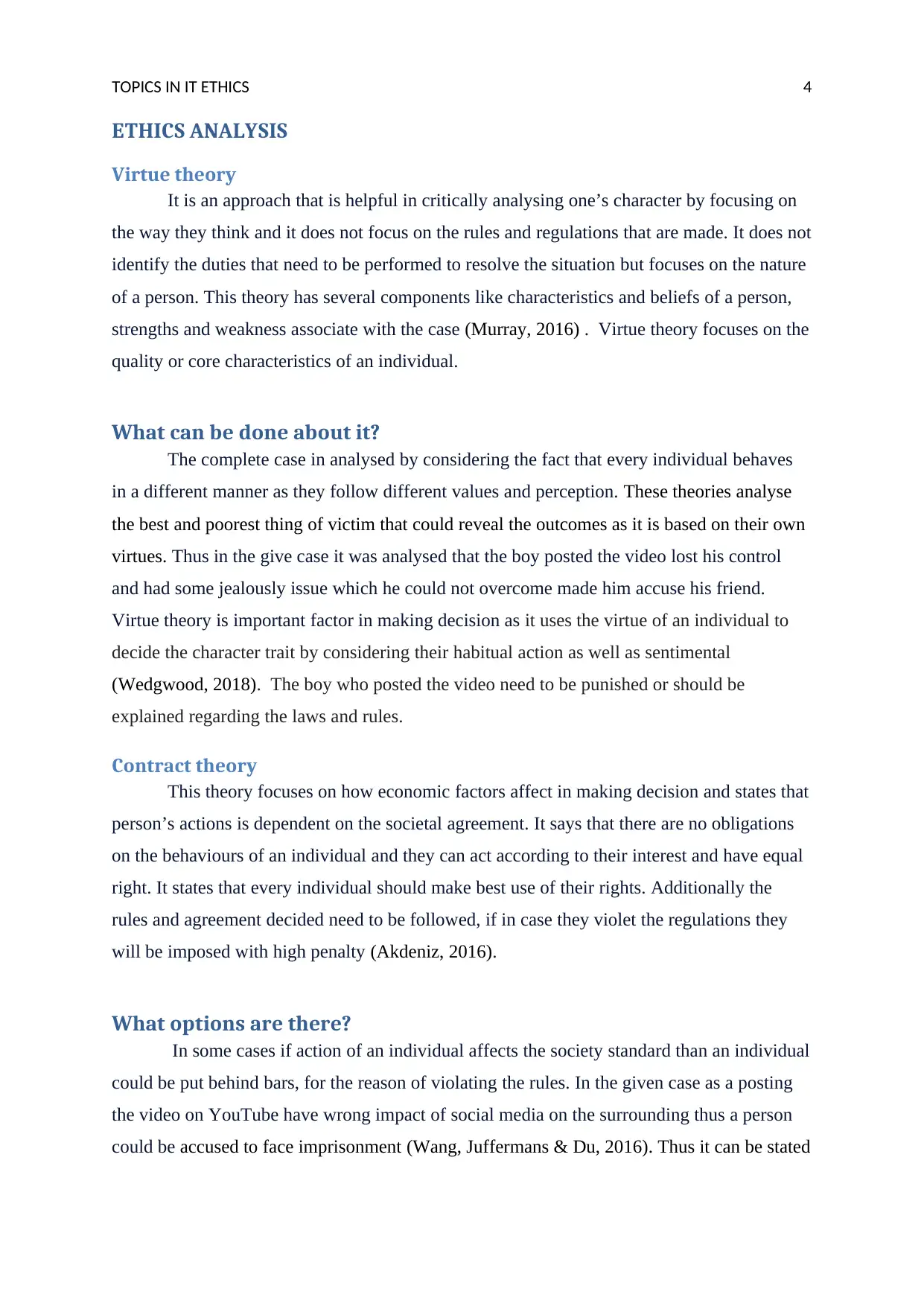
TOPICS IN IT ETHICS 4
ETHICS ANALYSIS
Virtue theory
It is an approach that is helpful in critically analysing one’s character by focusing on
the way they think and it does not focus on the rules and regulations that are made. It does not
identify the duties that need to be performed to resolve the situation but focuses on the nature
of a person. This theory has several components like characteristics and beliefs of a person,
strengths and weakness associate with the case (Murray, 2016) . Virtue theory focuses on the
quality or core characteristics of an individual.
What can be done about it?
The complete case in analysed by considering the fact that every individual behaves
in a different manner as they follow different values and perception. These theories analyse
the best and poorest thing of victim that could reveal the outcomes as it is based on their own
virtues. Thus in the give case it was analysed that the boy posted the video lost his control
and had some jealously issue which he could not overcome made him accuse his friend.
Virtue theory is important factor in making decision as it uses the virtue of an individual to
decide the character trait by considering their habitual action as well as sentimental
(Wedgwood, 2018). The boy who posted the video need to be punished or should be
explained regarding the laws and rules.
Contract theory
This theory focuses on how economic factors affect in making decision and states that
person’s actions is dependent on the societal agreement. It says that there are no obligations
on the behaviours of an individual and they can act according to their interest and have equal
right. It states that every individual should make best use of their rights. Additionally the
rules and agreement decided need to be followed, if in case they violet the regulations they
will be imposed with high penalty (Akdeniz, 2016).
What options are there?
In some cases if action of an individual affects the society standard than an individual
could be put behind bars, for the reason of violating the rules. In the given case as a posting
the video on YouTube have wrong impact of social media on the surrounding thus a person
could be accused to face imprisonment (Wang, Juffermans & Du, 2016). Thus it can be stated
ETHICS ANALYSIS
Virtue theory
It is an approach that is helpful in critically analysing one’s character by focusing on
the way they think and it does not focus on the rules and regulations that are made. It does not
identify the duties that need to be performed to resolve the situation but focuses on the nature
of a person. This theory has several components like characteristics and beliefs of a person,
strengths and weakness associate with the case (Murray, 2016) . Virtue theory focuses on the
quality or core characteristics of an individual.
What can be done about it?
The complete case in analysed by considering the fact that every individual behaves
in a different manner as they follow different values and perception. These theories analyse
the best and poorest thing of victim that could reveal the outcomes as it is based on their own
virtues. Thus in the give case it was analysed that the boy posted the video lost his control
and had some jealously issue which he could not overcome made him accuse his friend.
Virtue theory is important factor in making decision as it uses the virtue of an individual to
decide the character trait by considering their habitual action as well as sentimental
(Wedgwood, 2018). The boy who posted the video need to be punished or should be
explained regarding the laws and rules.
Contract theory
This theory focuses on how economic factors affect in making decision and states that
person’s actions is dependent on the societal agreement. It says that there are no obligations
on the behaviours of an individual and they can act according to their interest and have equal
right. It states that every individual should make best use of their rights. Additionally the
rules and agreement decided need to be followed, if in case they violet the regulations they
will be imposed with high penalty (Akdeniz, 2016).
What options are there?
In some cases if action of an individual affects the society standard than an individual
could be put behind bars, for the reason of violating the rules. In the given case as a posting
the video on YouTube have wrong impact of social media on the surrounding thus a person
could be accused to face imprisonment (Wang, Juffermans & Du, 2016). Thus it can be stated
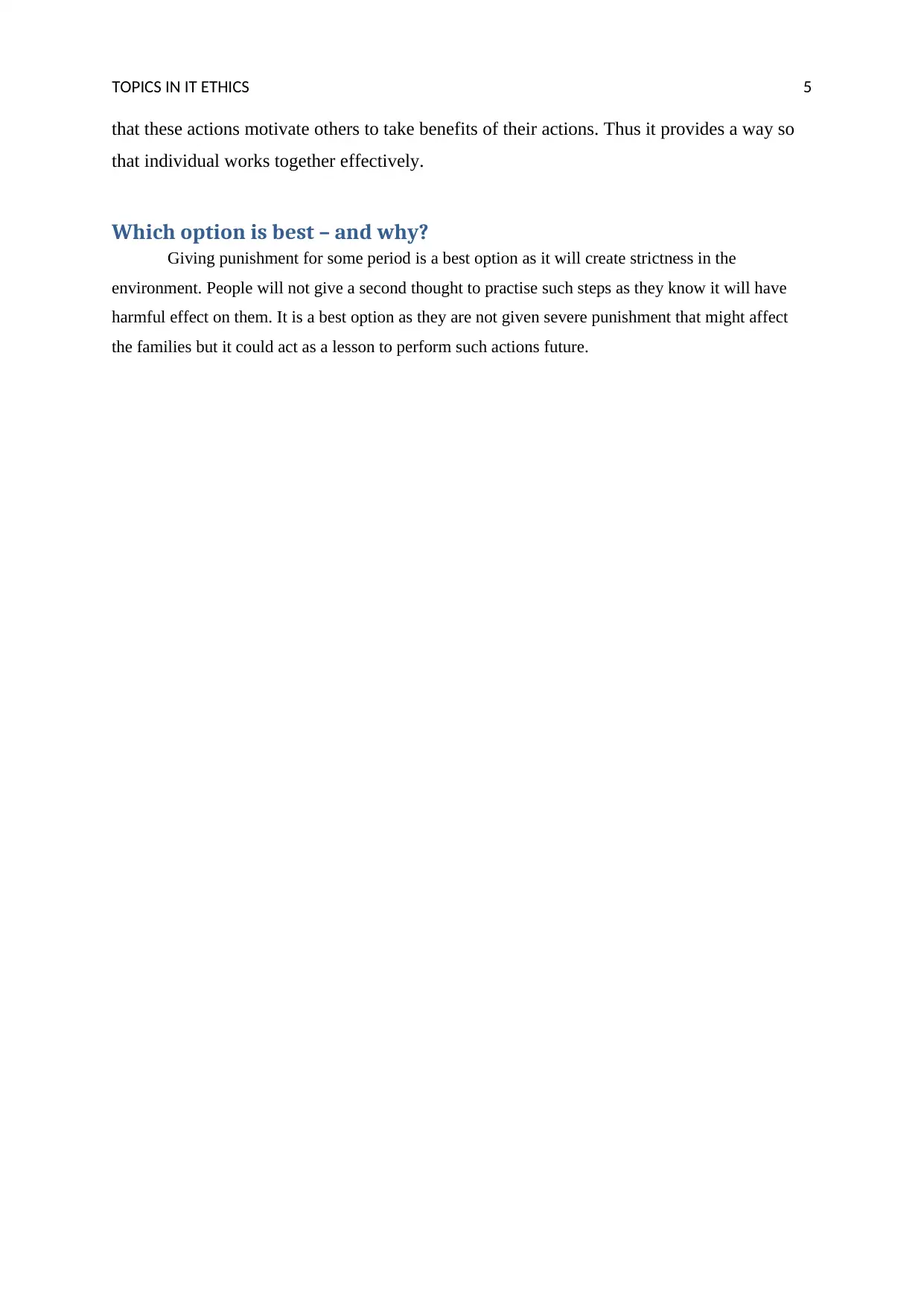
TOPICS IN IT ETHICS 5
that these actions motivate others to take benefits of their actions. Thus it provides a way so
that individual works together effectively.
Which option is best – and why?
Giving punishment for some period is a best option as it will create strictness in the
environment. People will not give a second thought to practise such steps as they know it will have
harmful effect on them. It is a best option as they are not given severe punishment that might affect
the families but it could act as a lesson to perform such actions future.
that these actions motivate others to take benefits of their actions. Thus it provides a way so
that individual works together effectively.
Which option is best – and why?
Giving punishment for some period is a best option as it will create strictness in the
environment. People will not give a second thought to practise such steps as they know it will have
harmful effect on them. It is a best option as they are not given severe punishment that might affect
the families but it could act as a lesson to perform such actions future.
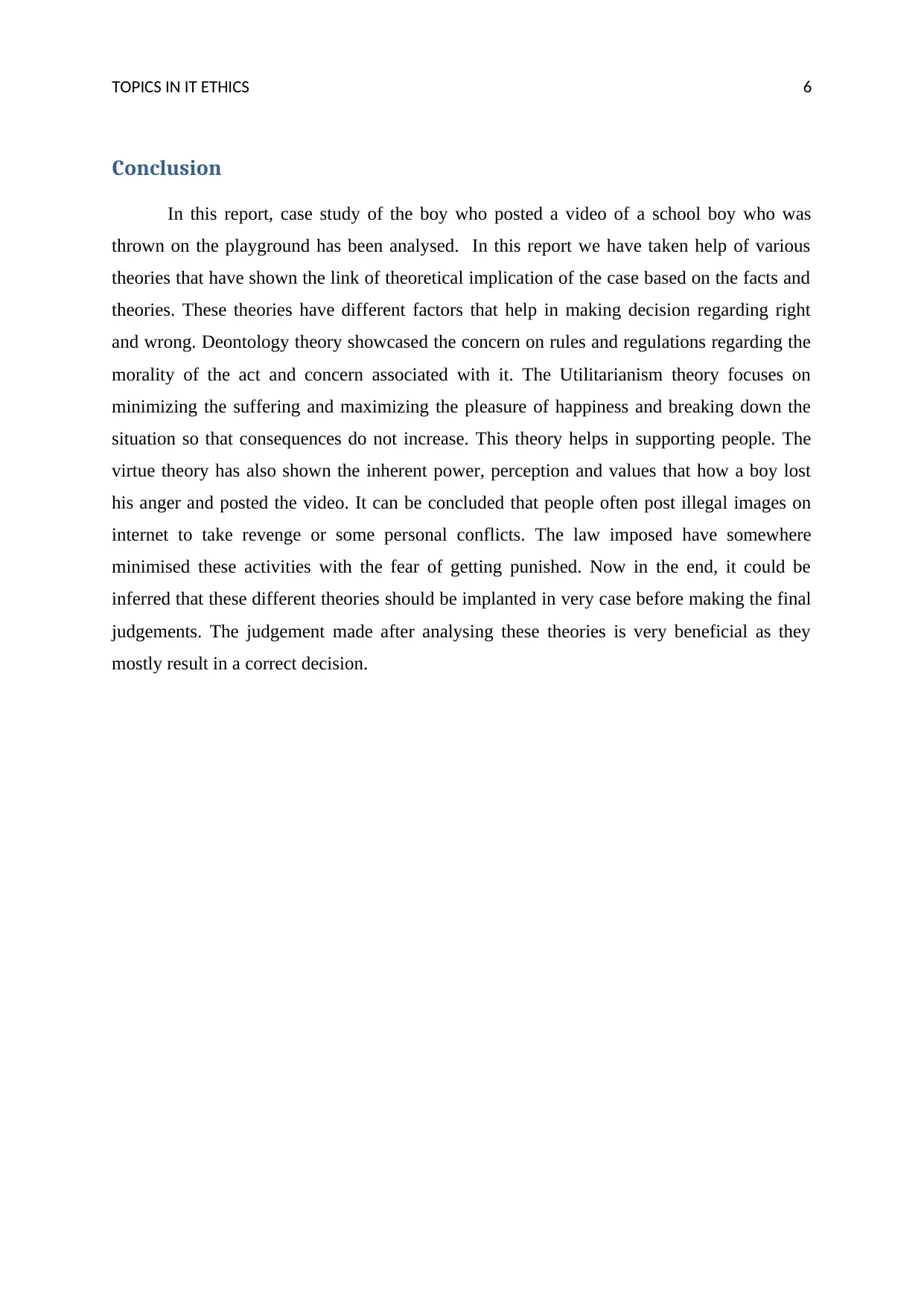
TOPICS IN IT ETHICS 6
Conclusion
In this report, case study of the boy who posted a video of a school boy who was
thrown on the playground has been analysed. In this report we have taken help of various
theories that have shown the link of theoretical implication of the case based on the facts and
theories. These theories have different factors that help in making decision regarding right
and wrong. Deontology theory showcased the concern on rules and regulations regarding the
morality of the act and concern associated with it. The Utilitarianism theory focuses on
minimizing the suffering and maximizing the pleasure of happiness and breaking down the
situation so that consequences do not increase. This theory helps in supporting people. The
virtue theory has also shown the inherent power, perception and values that how a boy lost
his anger and posted the video. It can be concluded that people often post illegal images on
internet to take revenge or some personal conflicts. The law imposed have somewhere
minimised these activities with the fear of getting punished. Now in the end, it could be
inferred that these different theories should be implanted in very case before making the final
judgements. The judgement made after analysing these theories is very beneficial as they
mostly result in a correct decision.
Conclusion
In this report, case study of the boy who posted a video of a school boy who was
thrown on the playground has been analysed. In this report we have taken help of various
theories that have shown the link of theoretical implication of the case based on the facts and
theories. These theories have different factors that help in making decision regarding right
and wrong. Deontology theory showcased the concern on rules and regulations regarding the
morality of the act and concern associated with it. The Utilitarianism theory focuses on
minimizing the suffering and maximizing the pleasure of happiness and breaking down the
situation so that consequences do not increase. This theory helps in supporting people. The
virtue theory has also shown the inherent power, perception and values that how a boy lost
his anger and posted the video. It can be concluded that people often post illegal images on
internet to take revenge or some personal conflicts. The law imposed have somewhere
minimised these activities with the fear of getting punished. Now in the end, it could be
inferred that these different theories should be implanted in very case before making the final
judgements. The judgement made after analysing these theories is very beneficial as they
mostly result in a correct decision.
Paraphrase This Document
Need a fresh take? Get an instant paraphrase of this document with our AI Paraphraser
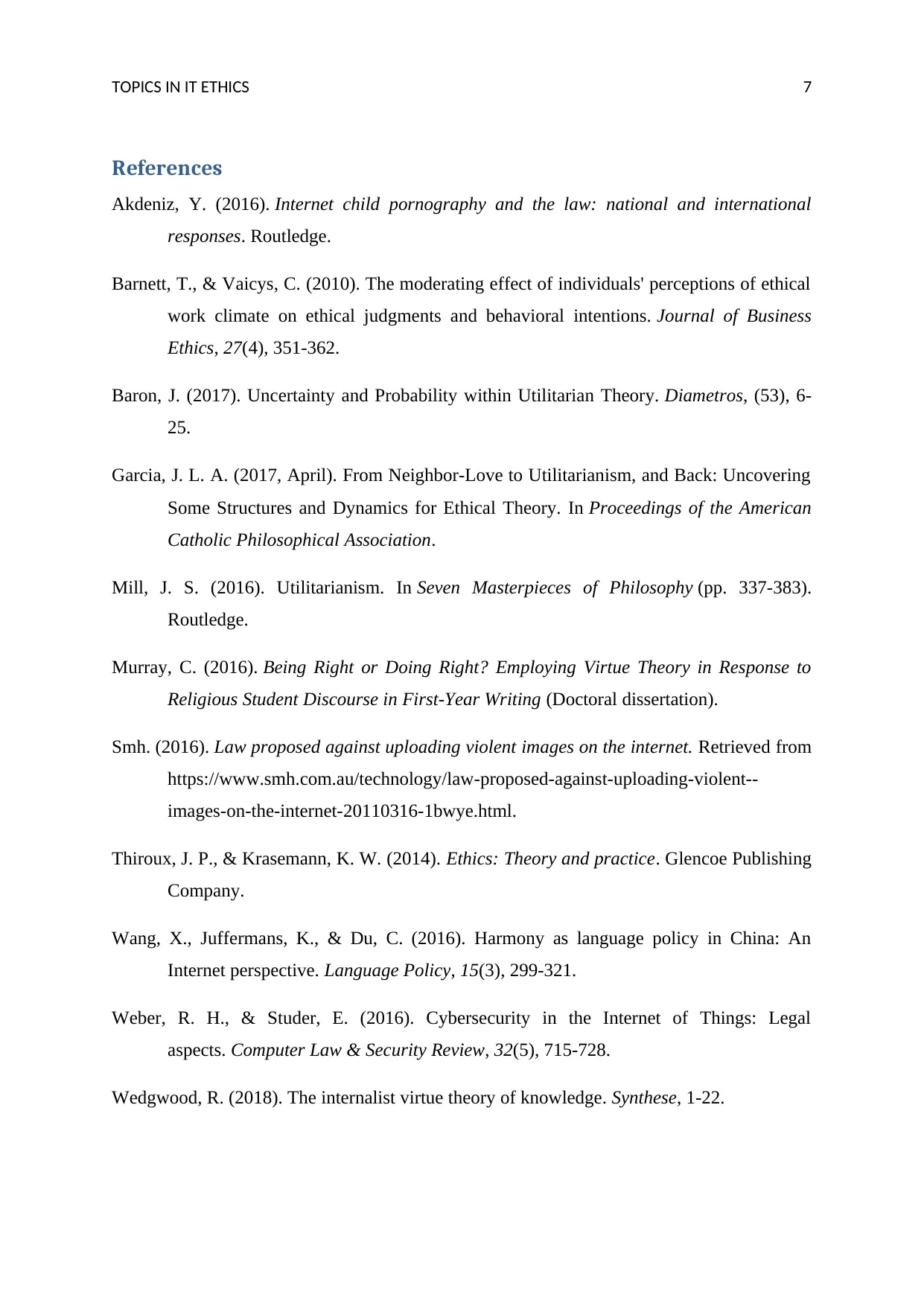
TOPICS IN IT ETHICS 7
References
Akdeniz, Y. (2016). Internet child pornography and the law: national and international
responses. Routledge.
Barnett, T., & Vaicys, C. (2010). The moderating effect of individuals' perceptions of ethical
work climate on ethical judgments and behavioral intentions. Journal of Business
Ethics, 27(4), 351-362.
Baron, J. (2017). Uncertainty and Probability within Utilitarian Theory. Diametros, (53), 6-
25.
Garcia, J. L. A. (2017, April). From Neighbor-Love to Utilitarianism, and Back: Uncovering
Some Structures and Dynamics for Ethical Theory. In Proceedings of the American
Catholic Philosophical Association.
Mill, J. S. (2016). Utilitarianism. In Seven Masterpieces of Philosophy (pp. 337-383).
Routledge.
Murray, C. (2016). Being Right or Doing Right? Employing Virtue Theory in Response to
Religious Student Discourse in First-Year Writing (Doctoral dissertation).
Smh. (2016). Law proposed against uploading violent images on the internet. Retrieved from
https://www.smh.com.au/technology/law-proposed-against-uploading-violent--
images-on-the-internet-20110316-1bwye.html.
Thiroux, J. P., & Krasemann, K. W. (2014). Ethics: Theory and practice. Glencoe Publishing
Company.
Wang, X., Juffermans, K., & Du, C. (2016). Harmony as language policy in China: An
Internet perspective. Language Policy, 15(3), 299-321.
Weber, R. H., & Studer, E. (2016). Cybersecurity in the Internet of Things: Legal
aspects. Computer Law & Security Review, 32(5), 715-728.
Wedgwood, R. (2018). The internalist virtue theory of knowledge. Synthese, 1-22.
References
Akdeniz, Y. (2016). Internet child pornography and the law: national and international
responses. Routledge.
Barnett, T., & Vaicys, C. (2010). The moderating effect of individuals' perceptions of ethical
work climate on ethical judgments and behavioral intentions. Journal of Business
Ethics, 27(4), 351-362.
Baron, J. (2017). Uncertainty and Probability within Utilitarian Theory. Diametros, (53), 6-
25.
Garcia, J. L. A. (2017, April). From Neighbor-Love to Utilitarianism, and Back: Uncovering
Some Structures and Dynamics for Ethical Theory. In Proceedings of the American
Catholic Philosophical Association.
Mill, J. S. (2016). Utilitarianism. In Seven Masterpieces of Philosophy (pp. 337-383).
Routledge.
Murray, C. (2016). Being Right or Doing Right? Employing Virtue Theory in Response to
Religious Student Discourse in First-Year Writing (Doctoral dissertation).
Smh. (2016). Law proposed against uploading violent images on the internet. Retrieved from
https://www.smh.com.au/technology/law-proposed-against-uploading-violent--
images-on-the-internet-20110316-1bwye.html.
Thiroux, J. P., & Krasemann, K. W. (2014). Ethics: Theory and practice. Glencoe Publishing
Company.
Wang, X., Juffermans, K., & Du, C. (2016). Harmony as language policy in China: An
Internet perspective. Language Policy, 15(3), 299-321.
Weber, R. H., & Studer, E. (2016). Cybersecurity in the Internet of Things: Legal
aspects. Computer Law & Security Review, 32(5), 715-728.
Wedgwood, R. (2018). The internalist virtue theory of knowledge. Synthese, 1-22.

TOPICS IN IT ETHICS 8
1 out of 9
Related Documents
Your All-in-One AI-Powered Toolkit for Academic Success.
+13062052269
info@desklib.com
Available 24*7 on WhatsApp / Email
![[object Object]](/_next/static/media/star-bottom.7253800d.svg)
Unlock your academic potential
© 2024 | Zucol Services PVT LTD | All rights reserved.




